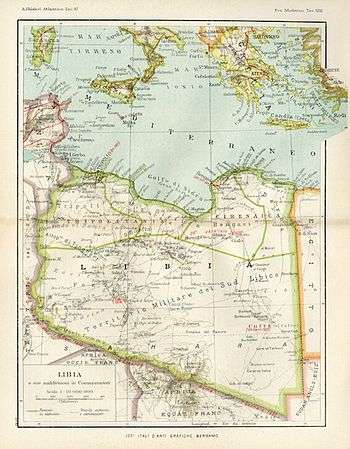Italian concentration camps in Libya

Fascist Italy maintained several concentration camps in Cyrenaica (Eastern Libya) during the later phase of its occupation of that country. After the initial invasion in 1911, the Italian control over much of the country remained ineffective. In the face of the armed Arab opposition, mainly in Cyrenaica under the leadership of Omar Mukhtar, Italian forces under the Generals Pietro Badoglio and Rodolfo Graziani waged punitive pacification campaigns which turned into brutal and bloody acts of repression.
The Frontier Wire, a barbed wire fence was built from the Mediterranean to the oasis of Al-Jaghbub to sever lines critical to the resistance. Soon afterwards, the colonial administration began the wholesale deportation of the people of the Jebel Akhdar to deny the rebels the support of the local population. The forced migration of more than 100,000 people ended in concentration camps in Suluq, El Magrun, Abyar and El Agheila where tens of thousands died in squalid conditions.
Overall, five main and ten smaller concentration camps were established. Badoglio proposed to convert the camps into permanent settlements, but this was prevented by the dismal living and economic conditions in the camps.[1]
Estimates of deaths in concentration camps
Estimates of the people who died in these camps vary. It is estimated that the number of Libyans who died - killed either through combat or mainly through starvation and disease - is at a minimum of 80,000 or even up to one third of the Cyrenaican population. Pappé estimates that between 1928 and 1932 the Italian military "killed half the Bedouin population (directly or through starvation in camps)."[2] In his book Cerinaica today,Dr. Todesky, who in 1931 was the director of the Italian Army Health Services, states "From May 1930 to September 1930 more than 80,000 Libyans were forced to leave their land and live in concentration camps, they were taken 300 at a time watched by soldiers to make sure that the Libyans go directly to the concentration camps" and "By the end of 1930 all Libyans who live in tents were forced to go and live in the camps. 55% of the Libyans died in the camps." Italian historian Gentile wrote that this figure was excessive, and only a few thousands died, mainly of disease and starvation.
2008 cooperation treaty
On 30 August 2008, Gaddafi and Italian Prime Minister Silvio Berlusconi signed a historic cooperation treaty in Benghazi.[3][4] Under its terms, Italy will pay $5 billion to Libya as compensation for its former military occupation. In exchange, Libya will take measures to combat illegal immigration coming from its shores and boost investments in Italian companies.[3][5] The treaty was ratified by Italy on 6 February 2009, and by Libya on 2 March, during a visit to Tripoli by Berlusconi.[3][6]
References
- ↑ Baldinetti, Anna (2014). The Origins of the Libyan Nation: Colonial Legacy, Exile and the Emergence of a New Nation-State. Routledge. p. 48. ISBN 9781135245023.
- ↑ Ilan Pappé, The Modern Middle East.Routledge, 2005, ISBN 0-415-21409-2, p. 26
- 1 2 3 "Gaddafi to Rome for historic visit". ANSA. 2009-06-10. Retrieved 2009-06-10.
- ↑ "Berlusconi in Benghazi, Unwelcome by Son of Omar Al-Mukhtar". The Tripoli Post. 2008-08-30. Retrieved 2009-06-10.
- ↑ "Italia-Libia, firmato l'accordo". La Repubblica. 2008-08-30. Retrieved 2009-06-10.
- ↑ "Libya agrees pact with Italy to boost investment". Alarab Online. 2009-03-02. Retrieved 2009-06-10.
